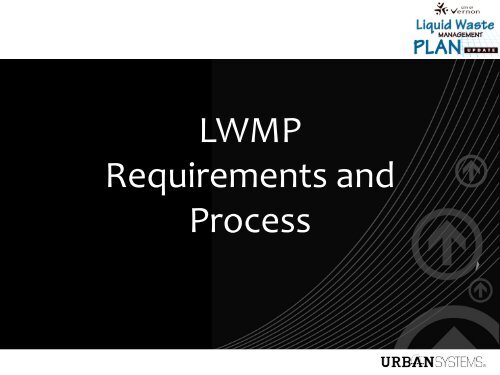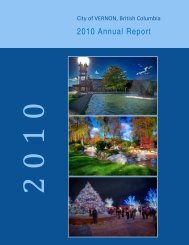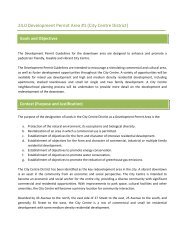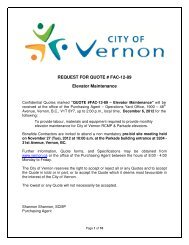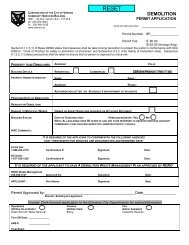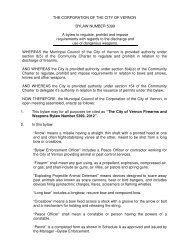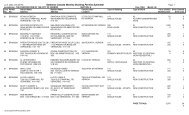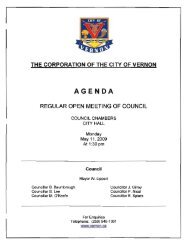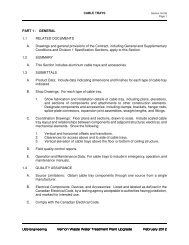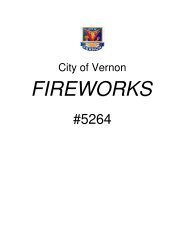Meeting #1 LWMP Overview Presentation - City of Vernon
Meeting #1 LWMP Overview Presentation - City of Vernon
Meeting #1 LWMP Overview Presentation - City of Vernon
Create successful ePaper yourself
Turn your PDF publications into a flip-book with our unique Google optimized e-Paper software.
<strong>LWMP</strong><br />
Requirements and<br />
Process
<strong>LWMP</strong> Primer<br />
• Environmental Management Act allows municipalities and regional<br />
districts ability to develop a Liquid Waste Management Plan (<strong>LWMP</strong>)<br />
• Encouraged by BC Ministry <strong>of</strong> Environment (MOE) as a legal document<br />
that provides the long-term direction and strategy for management <strong>of</strong><br />
liquid waste (sanitary sewer and stormwater)<br />
• MOE’s long-term goal is to achieve zero pollution. Pro-Active strategy<br />
to achieve this goal includes:<br />
― Pollution Prevention (3 R’s – reduce, reuse, recycle)<br />
― BACT (Best Available Control Technology) – to facilitate pollution<br />
prevention, resource recovery and residuals management (5 R’s)<br />
― PPP (Polluter Pay Principle) – waste discharge permit fees will<br />
assist in achieving the goal <strong>of</strong> zero pollution
<strong>LWMP</strong> Primer<br />
• Link between Official Community Plan (OCP) and <strong>LWMP</strong><br />
― OCP identifies community vision and environmental policies<br />
― OCP outlines development pattern, location, and sequencing<br />
• <strong>LWMP</strong>s are undertaken in 3 Stages:<br />
― Stage 1: Identify Issues and List <strong>of</strong> Potential Solutions –<br />
discussion <strong>of</strong> values and guiding principles<br />
― Stage 2: Analysis and Costing <strong>of</strong> Solutions and Formulation <strong>of</strong><br />
Preferred Alternatives<br />
― Stage 3: Selection <strong>of</strong> Best Apparent Alternative and<br />
Formalizing <strong>LWMP</strong> – <strong>Vernon</strong> Council and MOE Sign-Off
<strong>LWMP</strong> Primer<br />
• Applies 3 Bottom Lines to All Potential Options:<br />
― Environment<br />
― Social<br />
― Financial<br />
• Public input mandated through all stages. Two<br />
committees have been established for the<br />
process:<br />
― Technical Advisory Committee (TAC)<br />
― Local Advisory Committee (LAC)<br />
― Estimated 4 joint TAC/LAC meetings, and 3-<br />
4 TAC meetings over the next 12-18 months<br />
― All committee meetings are open to the<br />
public
History <strong>of</strong><br />
Wastewater<br />
Treatment in<br />
<strong>Vernon</strong> and Area
The 1985 <strong>LWMP</strong><br />
• 15 Options Evaluated<br />
• Selected Options:<br />
― Continue Commonage irrigation<br />
― Do not expand land base<br />
― Excess to deep lake outfall<br />
• Capital Cost $54.9 M<br />
• Implementation:<br />
― New plant not built; existing plant<br />
upgraded<br />
― Commonage irrigation land base<br />
expanded<br />
― Deep outfall built, but not used<br />
― Decided in 1993 to update the<br />
<strong>LWMP</strong><br />
• Later Concerns:<br />
― Operating Costs > $1.3 M/year<br />
― Okanagan Lake (phosphorus)<br />
― Treatment Plant location<br />
― Water supply (limited success)
The 1995 <strong>LWMP</strong><br />
• 11 Options Evaluated<br />
• Selected Option (Alternative 5):<br />
― Expand agricultural irrigation<br />
― Implement DWD (Dual Water Distribution)<br />
― Use existing plant to capacity<br />
― Build a new plant at Giant site<br />
― Abandon lake outfall<br />
• Capital Cost: $62.2 M<br />
• Not Implemented
2000 Peer Review<br />
Conclusions <strong>of</strong> Peer Review:<br />
• Capital Costs are Underestimated<br />
• Power Costs are Underestimated<br />
• Costs <strong>of</strong> DWD are Underestimated<br />
• Total Difference ≈ $44 M ($106M)<br />
• Giant Site has Major Drawbacks<br />
• Protocol for DWD not Established
2000 to 2010<br />
• Major plant upgrade completed in 2005<br />
• New plant capacity: 27,000 m³/d<br />
• Operating Certificate amended January 2008 (ME12215)<br />
―<br />
―<br />
―<br />
Plant can produce effluent suitable for both irrigation<br />
and lake discharge (BNR – modified Johannesburg<br />
process)<br />
60-day notice to MoE required for planned lake<br />
discharge<br />
• (an emergency discharge protocol exists as well)<br />
Current ADWF 12,500 m³/d<br />
• Plant bio-solids processed and trucked to the Regional<br />
Biosolids Composting Facility composting facility for<br />
production <strong>of</strong> “Ogo-grow” soil amendment product<br />
• No lake discharges have occurred since 1998
<strong>Overview</strong> <strong>of</strong> Current Concerns<br />
• High costs <strong>of</strong> operating effluent<br />
irrigation system<br />
• Potential risks resulting from lake<br />
discharges<br />
• Expansion <strong>of</strong> land base for irrigation –<br />
adequacy <strong>of</strong> storage<br />
• Impact <strong>of</strong> high strength wastewater<br />
from industry and trucked waste<br />
• Odour control at bio-solids composting<br />
facility<br />
• Commitments to reclaimed water users<br />
• Climate change and impact on water<br />
supply (DWD)<br />
• Source control and I/I reduction
Current<br />
Wastewater Issues
Current Wastewater Issues<br />
<strong>Vernon</strong>’s Liquid Waste Management Approach<br />
• Collection<br />
• Treatment<br />
• Reclaimed Water Re-use<br />
• Stormwater Management<br />
Issues Identified<br />
• Leading to Management Options
Identifying the Issues: Collection System → Quality<br />
Un-serviced Residences<br />
• Lake Water Quality Impacts<br />
• 2 to 4% <strong>of</strong> properties are un-serviced<br />
Inflow and Infiltration<br />
• Flow Range: 20 to 30% (seasonal)<br />
Industrial Waste<br />
• Trucked Waste and Industry<br />
• BOD 5 concentrations are 60% higher<br />
• Plant Capacity: Flow versus Nutrient Loading<br />
Private Facility Overflows
Identifying the Issues: <strong>Vernon</strong> Water Reclamation<br />
Center<br />
- Plant Optimization<br />
• Climate Action Charter 2012<br />
• Reduce GHGs at the Plant<br />
• Energy Use vs Plant Processes<br />
• Spray Irrigation or Okanagan<br />
Lake Outfall<br />
- Backup Power<br />
- Microconstituents in our receiving<br />
waters
Identifying the Issues: Reclaimed Water Re-use<br />
Land Base<br />
• <strong>City</strong> growth = increased application<br />
• Shrinking Land Base<br />
• <strong>City</strong> Owned vs. Private vs. Crown<br />
System Capacity<br />
• Function <strong>of</strong> land, weather, irrigation scheduling,<br />
on-site operations, etc.<br />
• Is there a market for reclaimed water use<br />
Cost Recovery<br />
• Subsidized program<br />
• Limitations on increases
Identifying the Issues: Reclaimed Water Re-use<br />
Energy Use<br />
• $400,000 spent in 2009<br />
• Backup Power<br />
Education<br />
• Existing Practices<br />
• Quality <strong>of</strong> reclaimed water<br />
Provincial Regulations
Identifying the Issues: Biosolids Management<br />
Odour Complaints<br />
• Stressed Facility<br />
• Seasonal Variability
Identifying the Issues: Stormwater Management<br />
Integrated Framework<br />
• Irrigation Run<strong>of</strong>f<br />
Water Quality Standards<br />
• Sensitive Habitats<br />
• Stormwater Outfalls<br />
High Risk Locations<br />
• Traffic Accidents<br />
• Industrial / Chemical Spills
Identifying the Issues: Financing the Program and<br />
the Assets<br />
Utility Rate Increases<br />
• Amortization Status<br />
• Capital Upgrades<br />
Trucked / Industrial Waste<br />
How should we approach solving the problems<br />
What might some <strong>of</strong> the options include<br />
How do we select options to investigate further
Identifying the Issues: Now Solving the Issues<br />
How should we approach solving the problems<br />
What might some <strong>of</strong> the options include<br />
How do we select options to investigate further<br />
How should our community values influence our decision<br />
making


